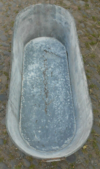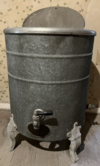Do towel baths? The german government was suggesting it when there was gas shortage.
Kind Regards, John
Do towel baths? The german government was suggesting it when there was gas shortage.

Are you feeling alright?10KW for 3mins or 3KW immersion for 20 mins... No contest. Even if it heats sufficiently in 20 mins. In 20 mins.


 we would fill with the wash tub boiler
we would fill with the wash tub boiler  glad to say those days are gone.
glad to say those days are gone.The Eberspacher is the most well know, comes as both 12 volt and 24 volt, caravans use a Carver Cascade 2 gas water heater, but the stored water is very limited around 5 gallons,
Last time I worked out the cost of a bath, heated by a gas boiler, I think it came in at around 30p. A similar bath of water, heated by electric would be around 3.5x that cost, so around £1.05.
For the bath I'm currently using an old immersion tank and heater. But it takes forever to heat up and the bath is not full wasting a ton of energy.

I live where there is no piped gas, but loads of people use LPG or oil. My oil boiler is 20 kW, and heart of winter runs around ¾ of the time, so for electric looking at about the same or more to be able to switch off, then back on again when needed, don't want to run it 24/7 so the larger it is, the less time to re-heat the home.I have a 2 bed bungalow electric only, no gas in the area.

About 4 kW for my 12kW HPOK a heat pump may need less
I don't think it will take as long to repurpose an infrastructure as to develop it initially..to think we can change in less than 100 years

So for my house looking at 8 kW or around half of the total supply to house, so not going to work. Same applies to electric vehicles.About 4 kW for my 12kW HP
As has been said, to have baths (rather than showers) if one is reliant on electrical heating of water is an expensive luxury.I have a 2 bed bungalow electric only, no gas in the area. I have an electric shower and 2 tankless electric water heaters for the bathroom and kitchen sinks. For the bath I'm currently using an old immersion tank and heater. But it takes forever to heat up and the bath is not full wasting a ton of energy.

If you've determined your house needs heat input of 24kW then yep, that ASHP would usually have an 8kW draw.. But 24kW is massive in HP terms - you'd be better off embarking on a comprehensive upgrade of your insulation and draftproofing to reduce the demand, not fitting a massive heat producer to overcome a large lossSo for my house looking at 8 kW or around half of the total supply to house, so not going to work. Same applies to electric vehicles.
...The common situation is that in which people want hot water to always be available (not just for baths), so their system is arranged such that the cylinder is always full of fairly hot water. However, if you want the cylinder only for filling baths, then you would simply need to switch the immersion on, say, 3 or more hours before you intend to take a bath (using a time switch to do that if necessary)....
I have loads of wood in stock, and an open hearth, but that is really bad for the environment with particular emissions etc.
All true. The point I was making was that, in the apparent (unusual) case of thee OP wanting immersion-heated water for baths, then, even if his cylinder were fairly poorly insulated, if he switched it on, say, 3 hours before a bath was required (with a times witch, if, for example, he would be asleep at that time) (and then turn it off when he had his bath), then heat loss would be pretty low.If you have very good insulation of the cylinder and pipes, the timing is not very important. The thermostat will turn off the element once the water reaches your target temperature (unless it is faulty, in which case it must be replaced). A timer will save you money if you have a time-related source of cheap electricity, such as Solar power or Economy 7.
If you need to find a tradesperson to get your job done, please try our local search below, or if you are doing it yourself you can find suppliers local to you.
Select the supplier or trade you require, enter your location to begin your search.
Are you a trade or supplier? You can create your listing free at DIYnot Local
